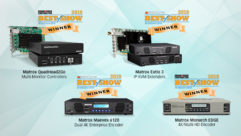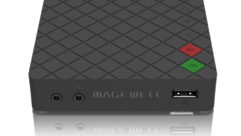NARROWING THE FIELD
Jun 1, 2002 12:00 PM,
NATHANIEL HECHT
SOMETIMES DECIDING WHAT KIND OF VIDEO display product to use in a venue or application in a themed environment can be tricky. Besides the limitations of budget — often the final arbiter of all good design intentions — there are environmental aspects to consider such as ambient light, sight lines and field of view. The following are aspects that should be considered as you narrow down the field of video display products to the one you will finally choose.
Ambient Light. If the light level is low, such as in a club or bar, then there usually isn’t a problem with most video displays. But in a room that is too bright with ambient light, proper viewing and color balance are difficult to achieve. In high ambient light, projection screens can suffer from reflections and washed-out colors.
A common problem arises when a video projection system is installed without checking on sun angles as the seasons change, especially in Northern cities. During the summer months the sun tracks higher in the sky, which means that a window may be shielded from solar gain. When the fall and winter months come and the sun tracks lower across the sky, an improperly shaded window will allow direct sunlight into a room, and it may fall across a video screen. That problem is especially common in houses of worship, in which floor to ceiling window glazing is normal. The only product-based solution is to use high brightness projectors or LED displays. Non-projection CRT video displays also work well in high light applications, but often they do not have the surface area for longer distance viewing. Building videowalls from conventional CRT products allows for long-distance viewing, but that is an expensive solution.
Viewing Angle. During the design process, it is important to consider the entire audience or viewer area. Often, a wide angle of view is necessary to cover an audience or seating area, and many products are limited in their field of dispersion. In a sports bar, for example, a video monitor is the center of attention during a sporting event. A single-point projector, whether a front or rear design, may have problems covering a bar’s wide seating area with a good, color-balanced picture. Often it is better to combine a defined coverage-area product such as a projector with a number of well-placed CRTs, LCDs or plasma screens to enhance the ability of more viewers to see the action. Large plasma screens are an excellent choice for these kinds of applications, because they have up to 120 degrees of viewing angle — wide enough for most audience areas.
Defined Viewing Areas. Some applications include a specific, defined area for viewing. Here are some examples:
- A video theater within a theme park or museum
- A presentation area in a trade show booth or kiosk
- A retail store’s point-of-purchase display
In these applications, choosing a video display device may be a bit easier because so many options will suffice. These kinds of applications often have high-level audio playback, possibly including surround sound effects, and that also helps to define the audience area, even when they are located in larger rooms or open areas. The choice of display for such an area is likely to be based more on budget constraints or on more subjective issues such as appearance of the equipment or level of picture quality.
Maintenance. In venues that require long hours of operation and long product life-spans (on the order of years), the service interval, the cost of equipment maintenance and the product’s longevity must be taken into consideration. Conventional CRT display products are pretty straightforward in this regard: If the product doesn’t burn out quickly from being overdriven, it will probably last many years. CRT video walls and front or rear projection televisions are fairly reliable over time and may represent the lowest cost to the end user. They don’t have the highest picture quality, however.
Plasma displays are widely regarded as the product that provides the highest picture quality, but they are expensive and have shorter life spans than conventional video displays. Plasma screens also have problems at high altitude, with color balance and reception being affected by atmospheric pressure changes. In the case of video projectors, the chief maintenance problem is replacing lamps.
Dynamic Signage. In recent years video displays for advertising signage have seen a huge jump. There are so many applications for use of these products in retail environments that the growth of product sales in this area is sure to rise significantly, especially as the current crop of products become less expensive. Plasma displays are now routinely used in airports and other transportation sectors to display travel schedules, often replacing aging CRTs with burned in images from too many years of displaying the same linear data. Supermarkets are using plasma displays to highlight weekly and daily specials in eye-catching ways. Some movie theaters are using rear-projection video displays in place of lobby cards to promote current and coming attractions, and retail clothing stores are capturing the sights and sounds of the fashion runway to enhance the clothes-buying experience.
Display of images is one thing, but when data and words are necessary to display, it is important to pay careful attention to font size and style. Small font sizes make words on a screen almost undecipherable at any distance. Moving words across a screen is a popular eye-catching device in many of these applications, but the use of the wrong kind of font might block the message from getting delivered. For these reasons it is important that the design phase of a project includes the client, the general contractor and the artistic team and content providers. Goals should be clearly defined, and careful planning will ensure that the proper display product is selected.
In every case the installation and choice of a particular display device will need to be evaluated in the context of the application to determine the cost and convenience to the customer.
Nat Hecht is the editor of S&VC. E-mail him at [email protected].









